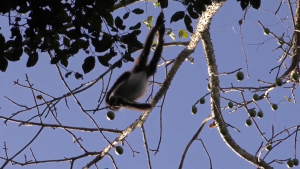
Calakmul – A Real Jungle Adventure
Part 2 – Calakmul Wildlife
A blog post by Lady Felicity
Calakmul was a very special place. Hopefully by now you’ll have read about our incredible jungle cabin accommodation in Greg’s last blog post (read it here if not) and in the next blog post you will be able to read about the unique Calakmul ruins. Once again I’m here to talk about some wildlife.
As our accommodation was in the Calakmul Biosphere Reserve, we could listen to the birds and, on occasion, howler monkeys in the distance from the comfort of our bed or hammock, protected from the insects by mosquito net walls.
When booking a guided tour (through our accommodation) for the Calakmul Archaeological Zone we saw that they also offer a guided tour through a section of the jungle to attempt to spot some wildlife. Naturally we jumped at this chance.
This lead to a 4:30am wake up call as our guide met us at the hotel reception at 5:30 and we were pleased to find that he was fairly fluent in English. He hopped into the back of our car and we set off on a 40 minute drive deeper into the jungle.
Our first stop was at a ‘car park’ aka a gravel ditch type space at the side of the road, from which a jungle trail led us away from the road and through the trees.
We soon spotted the rather vocal howler monkeys and, by comparison, beautifully dainty spider monkeys. (If you have never heard a howler monkey before, check out our video HERE – their call is rather distinctive!).
We also saw white-chested parrots, olive-chested parrots, lorikeets, and other similar species of birds whose names I can’t recall. There was also a roadside hawk perched in one tree giving us a bored look as we passed by.

Amongst the trees we saw a flash of white, which was actually the aptly named white tailed deer. We also saw male and female curassows running through the brush (these are large birds, once eaten by the Maya. They are a bit like over-sized, exotic looking pheasants).
Next we made a stop at a drying up swamp area which was home to lots of baby crocodiles and, apparently, the considerably larger mother who (thankfully!) remained buried amongst tree roots and mud.
At one point our guide climbed around the tree to see if it was possible to see the mother in her tree-root den. This put him between the baby infested swamp and the den itself making us somewhat nervous – what if the mother didn’t like anyone between her and her babies!? The guide assured us she has never attacked anyone… yet! Suffice to say Greg and I passed up on his offer to get any closer and try to see her for ourselves, I’ve seen enough nature documentaries, not to mention the film Crocodile Dundee!
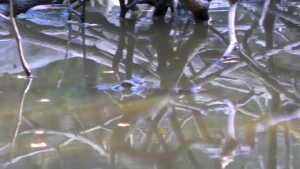
On our walk along the road back to our car I spotted an Agouti, the same creature I had spotted in the grounds of our hotel when staying in Palenque. Agouti, or Sereque as they are known in Mexico, are related to guinea pigs and have a similar face but a larger body and much longer legs. I know some people keep them as exotic pets but I always enjoy seeing animals in the wild, even if it’s just rabbits or guinea pig related creatures like these.
We went from our jungle walk to the Archaeological Zone and during our hour plus drive to the Calakmul Ruins along ‘roads’, with more potholes and craters than actual road (it became a bit of a game, with our guide trying to tell us which holes to avoid (and when it was just impossible to avoid them), and which side of the road to drive on so as best to avoid blowing our tyres! Apparently many people get the guide to drive their car as the road is too stressful for them. As you can imagine, this was not the case with Greg who quite enjoys a driving challenge! We also passed many wild Oscillated turkey (one of which decided to attack our car!) and even a wild boar!

The best part of the drive for me was when we stopped as a massive herd of Coati streamed through the jungle on either side of the road as well as across it. They were beautiful!
In English they are apparently known as hog-nosed coon! I can see why, as they do resemble (and are related to) raccoons and have a cute little up-turned nose. They are also double jointed like raccoons. Their ankles can rotate beyond 180° which allows them to descend a tree head first. We saw a lot of this as they flowed through the trees on either side of us. Quite fascinating to watch.
Coati are also known for their intelligence, also like raccoons. I note this in particular as it also links to my interest in spindle neurons. (If you read my blog about Whales -read HERE- you’ll have heard briefly about this) Only highly intelligent species such as humans, great apes, cetaceans and elephants have spindle neurons, but they have actually also found a lesser evolved version of these cells in raccoons. Such a rare thing, it makes me wonder quite how intelligent and emotionally diverse the raccoon and coati actually are.
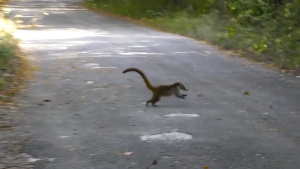
If you are anything like Greg and myself, if you like the wildlife, the tranquillity, the less touristy, more organic, untouched and more adventurous versions of everything, but still welcome a bit of luxury, Calakmul is definitely a place to visit in Mexico. The accommodation, ruins, wildlife – all of it was brilliant! I highly recommend the guided tours too, although make sure you book early if you need an English speaking guide.
Our guide was clearly passionate and very knowledgeable about his subject. He actually helps the archaeologists still working in Calakmul and he adores the nature too. We told him that on our journey from Palenque to Calakmul, in the middle of the day, we had been shocked to see a small black jaguar slinking across the road (a main road!) and, unsurprised, he explained that it was a Jaguarundi.
Where I had thought it must be a young unusually dark Jaguar, our guide explained they are actually just a bit smaller than a jaguar and have a black to brown/grey coat or in the case of the eyra, a red- chestnut coat. They are also known as ‘Otter-Cats’, and are related to the puma.
They are diurnal- usually active during the day rather than at night, and while they are fine in trees they prefer to hunt on the ground.
Jaguarundis make an unusually wide range of vocalisations, including purrs, whistles, yaps, chattering sounds, and even a bird-like chirp. I wish we had spotted it in the jungle and could have perhaps witnessed some of this but the fact we saw one at all really made our day! I was happy when a toucan flew over our car, let alone when a large(-ish) wild cat crossed in front of it! Amazing!
Our guide didn’t have any pictures of the Jaguarundi but he did show us some stunning pictures of the Jaguars and puma he has managed to encounter through the years.
Our time in the jungle and at the ruins with our guide was fascinating and terrific fun. If we had known in advance to hire an off-road vehicle, there are more ruins in the jungle, even more remote and untouched than the main ones we saw – which we could have visited with him. If we have the chance to return one day, it’s on our next to do list!
On this visit though, we had one more place to visit before leaving this amazing place.
At 3:40pm Greg and I drove though the jungle, returning to the main road. A short stretch along it took us to a little car park. There was just one other car when we arrived but it filled up (about 30 people in total) as we all waited for the sun to set.
A short walk through the jungle took us all to a dried up sink hole cavernous pit with a recessed cave area. In the cave, called Zots Cave, live bats. When we arrived we could see one or two had ventured out of the cave and were circling the pit in front of it.
While we waited for the rest of the bats to emerge we spotted that, feeding from the tree right in front of us, overhanging the sink hole pit, were Emerald hummingbirds. Maybe ten or so.
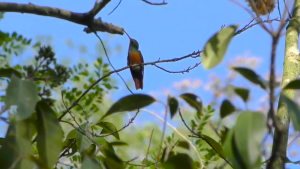
Hard to film, they are incredibly fast, though we got some good footage in the end. As warm up acts go, they were rather fantastic. So unexpected and delightful to watch.
To the Aztecs the hummingbird was the symbol of strength in life’s struggle to elevate consciousness—to follow your dreams.
At about 5:50 the hummingbirds flitted off and the bats came out to play. About three million of them. They circled around and around the cavern, up into the sky like a funnel or vortex till they found open air and space to filter out over the jungle and away into the evening sky. It is known as ‘volcan de los murcielagos’ meaning ‘Bats volcano’ and that suits it perfectly.
I went prepared with my waterproof coat (much to Greg’s amusement- it was swelteringly hot and he thought that only a usually freezing cold person like me could stand it in such heat), and, as it turned out, I wasn’t the only one. A few of us spectators wore our coats, in my case it was to deter the insects and mosquitoes, I suspect in many people’s cases it was to guard against bat guano (Some people also recommend covering your mouth and nose with a hanky or paper mask in case the bats stir up any cave mould. The air remained clear and odourless while we were there but that doesn’t necessarily mean it wasn’t there).
Though the bats flew above our heads, flitted around and amongst us, dark blurs that appeared to be brushing past our arms and legs, Greg and I escaped remarkably poo and bug-bite free.
After about 15 minutes of the amazing spectacle, people started to trickle away. We were the last to leave (after about 40 minutes with the bats), just before it got too dark to see the jungle path back to the car.
I’m glad we stayed as long as we did. The straggler bats flew closer and closer to us as the people left and the area opened up for them. It felt like such a privilege to see them (and the gorgeous hummingbirds!) like that.
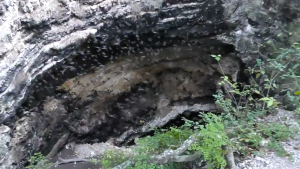
Eight different species of bat – seven types of fruit eating bat and one insectivore – live together in this cave, one of the top three caves in the world for bat biodiversity. The part of the cenote pit we can see is dry but apparently, in the cave, there is still a trickle of water for thirsty bats.
It’s a magical place and seemingly untouched by people, but for the gravel path to reach it.
It was a special evening and the perfect way to end the Mayan/ Aztec/ jungle part of our Mexico adventure before moving on to the marine part.
To quote our video – ‘Calakmul we like!’
Felicity
P.S.
If you enjoyed this blog post, please leave a comment and say ‘hello’!
For information on all of our projects, visit: www.gregandfelicityadventures.com
Follow us on Instagram at: https://www.instagram.com/gregandfelicity
Like us on Facebook at: https://www.facebook.com/GregandFelicityAdventures
There are various places you can watch our documentaries and series!
Seeking Cetaceans In Scotland: A two-part documentary about the work of the Cetacean Research and Rescue Unit as they work to help whales, dolphins and porpoises in the Moray Firth in Scotland:
Free in the USA on Tubi TV at:
https://tubitv.com/movies/678018/seeking-cetaceans-in-scotland
Free Worldwide on PlexTV at:
https://watch.plex.tv/movie/seeking-cetaceans-in-scotland
With a library card on the Hoopla service where applicable:
https://www.hoopladigital.com/title/15313766
Free in the USA on Xumo at:
https://www.xumo.tv/channel/99991731/free-documentaries?v=XM00ILOFXCKLUC&p=74071
Buy it without ads Amazon’s Prime Video at:
UK: https://www.amazon.co.uk/dp/B09RVWVFCV
USA: https://www.amazon.com/dp/B09RVWJGY1
(Greg and Felicity are donating half of our streaming income on this documentary to support the CRRU).
Available to buy on DVD (with £5 from each donated to the charity): https://ko-fi.com/s/73e469d114
ROMANIA: SEEKING DRACULA’S CASTLE: Our travel documentary looking into the history, legend and castles connected to Vlad Dracula III, sometimes known as Vlad the Impaler, and a journey around Romania:
Free Worldwide on Plex: https://watch.plex.tv/movie/romania-seeking-draculas-castle
Free (USA) on Tubi: https://tubitv.com/movies/579192/romania-seeking-dracula-s-castle
Prime Video (From £1.99, no Ads) (UK): https://www.amazon.co.uk//dp/B08RDPZP14
Prime Video (From $1.99, no Ads) (USA): https://www.amazon.com/dp/B08RDJR4F2
TURKEY: FAIRY CHIMNEYS AND UNDERGROUND CITIES: A travel documentary across Turkey, from the Fairy Chimneys and Underground Cities of Cappadocia to the ancient Greek ruins of Ephesus and Hierapolis:
Prime Video UK (From £2.49, no Ads): https://www.amazon.co.uk/Turkey-Fairy-Chimneys-Underground-Cities/dp/B09KKSZLRW
Prime Video USA (From $1.99, no Ads): https://www.amazon.com/Turkey-Fairy-Chimneys-Underground-Cities/dp/B09KK6VDJB
Free Worldwide on Plex: https://watch.plex.tv/movie/turkey-fairy-chimneys-and-underground-cities
Free (USA) on Tubi: https://tubitv.com/movies/579225/turkey-fairy-chimneys-and-underground-cities
Greg Chapman’s Magic Show: An eight-part series of magic and entertainment with Greg:
Free in the USA on Tubi at: https://tubitv.com/series/300008713/greg-chapman-s-magic-show
Free worldwide on Plex: https://watch.plex.tv/show/greg-chapmans-magic-show/season/1
Available to buy on DVD: https://ko-fi.com/s/7c1bc10a08
Mexico: Mayan Mystery and Marine Majesty: Filmed on our honeymoon in Mexico in 2019, our first travel documentary took us through the ancient sites of Teotihuacan, Uxmal, El Tajin, Palenque, Chichen Itza and Calakmul, and then on to see the whales of Magdalena Bay, whale sharks of La Paz, and more.
Watch free on YouTube: https://youtu.be/yfMpD868MHU
The Isle of Man: Railways, Castles and Seals: Our second travel documentary took us to the Isle of Man!
Watch free on YouTube: https://youtu.be/uCpUa6XEkbg